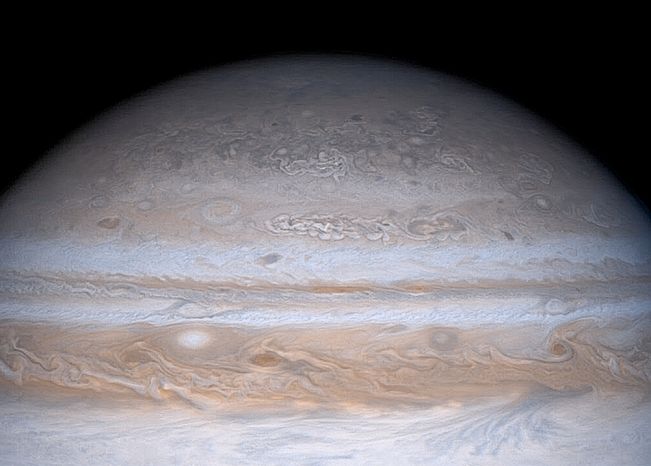
|
Explanation: Gas giant Jupiter is the solar system's largest world with about 320 times the mass of planet Earth. Famous for its Great Red Spot, Jupiter is also known for its regular, equatorial cloud bands, visible in very modest sized telescopes. The dark belts and light-colored zones of Jupiter's cloud bands are organized by planet girdling winds which reach speeds of up to 300 miles per hour. On toward the Jovian poles though, the cloud structures become more mottled and convoluted until, as in this Cassini spacecraft mosaic of Jupiter, the planet's polar region begins to look something like a brain! This striking equator-to-pole change in cloud patterns is not presently understood but may be due in part to the effect of Jupiter's rapid rotation or to convection vortices generated at high latitudes by the massive planet's internal heat loss. The Cassini spacecraft recorded this dramatically detailed view of Jupiter during its turn of the millennium flyby enroute to Saturn.
|
January February March April May June July August September October November December |
| ||||||||||||||||||||||||||||||||||||||||||||||||
NASA Web Site Statements, Warnings, and Disclaimers
NASA Official: Jay Norris. Specific rights apply.
A service of: LHEA at NASA / GSFC
& Michigan Tech. U.
Based on Astronomy Picture
Of the Day
Publications with keywords: Jupiter - pole - clouds - cassini spacecraft
Publications with words: Jupiter - pole - clouds - cassini spacecraft
See also:
- APOD: 2026 January 6 Á Jupiters Clouds in High Definition from Juno
- APOD: 2025 November 11 Á Jupiter in Ultraviolet from Hubble
- APOD: 2025 December 14 Á Juno Flyby of Ganymede and Jupiter
- APOD: 2025 August 17 Á Asperitas Clouds Over New Zealand
- APOD: 2025 May 25 Á Beneath Jupiter
- Painting with Jupiter
- APOD: 2025 April 2 Á Jupiter and Ring in Infrared from Webb
